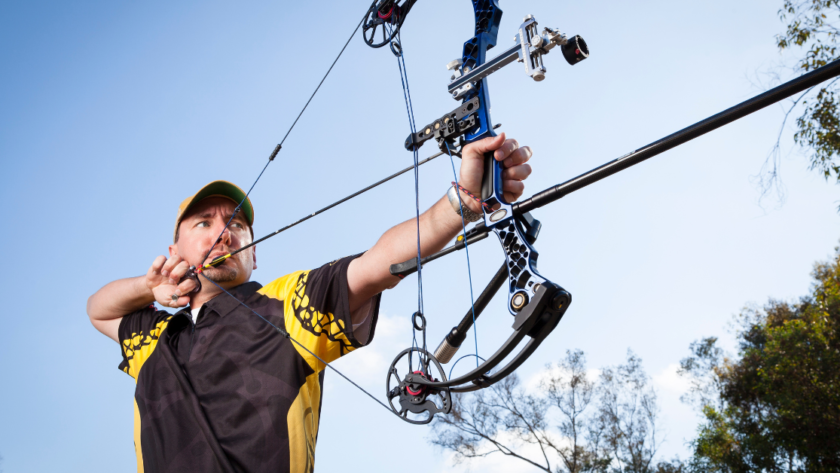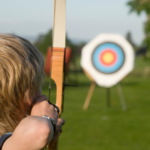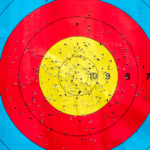Archery is a sport of precision, power, and patience. At it’s heart lies a crucial element that can make or break your performance: draw weight.
Understanding Draw Weight: The Backbone of Archery
Draw weight is the force required to pull back a bow’s string to full draw position. It’s measured in pounds (lbs) or kilograms (kg) and fundamentally influences arrow speed, accuracy, and overall shooting performance.
The concept of draw weight has a rich history. Ancient Egyptian bows from 3000 BCE had draw weights ranging from 40-50 lbs, while medieval English longbows could reach a staggering 185 lbs.
Today, we see a wide spectrum of draw weights tailored to different archery disciplines and archer capabilities.
The physics behind draw weight is fascinating. As you draw the bow, you’re converting your muscle energy into potential energy stored in the bow’s limbs.
Upon release, this energy transfers to the arrow, propelling it forward.
Higher draw weights store and transfer more energy, resulting in faster arrow speeds and potentially flatter trajectories.
However, selecting the right draw weight involves more than just choosing the highest number you can manage.
The ideal draw weight balances power and control, influenced by factors such as your physical strength, shooting technique, and intended use of the bow.
Finding Your Sweet Spot: Factors to Consider
Determining your ideal draw weight is a personal process, but several key factors come into play:
Physical Capabilities
Your strength, particularly in your back and shoulders, plays a crucial role. A draw weight that’s too heavy will lead to poor form and potential injury.
I’ve seen many archers, especially beginners, struggle with bows that are simply too powerful for them to control effectively.
Experience Level
Beginners should start with lower draw weights to focus on form and technique before progressing to heavier bows. As a novice, I started with a 25 lb recurve bow, which allowed me to develop proper form without straining.
Over time, I gradually increased my draw weight as my strength and skill improved.
Intended Use
Target archers often use lower draw weights for precision, while hunters may opt for higher weights for increased penetration power.
When I transitioned from target archery to bowhunting, I had to significantly increase my draw weight to confirm ethical kills.
Bow Type
Compound bows typically allow for higher draw weights because of their let-off system, which reduces the holding weight at full draw.
This means you can shoot a higher draw weight more comfortably with a compound bow compared to a recurve or longbow.
Shooting Frequency
If you plan to shoot for extended periods, a slightly lower draw weight may help prevent fatigue and maintain consistency.
During intensive training sessions, I’ve found that using a bow with a draw weight about 5-10 lbs lower than my most helps me maintain good form throughout long practice sessions.
The Journey to Your Perfect Draw Weight
Finding your ideal draw weight is an ongoing process. Here’s a step-by-step approach to guide you:
1. Start Conservative
Begin with a draw weight you can comfortably manage for many shots without straining. For adult beginners, this is often in the 20-30 lb range for recurve bows and 30-40 lb range for compound bows.
When I first started, I used a 25 lb recurve bow, which felt challenging but manageable.
2. Focus on Form
Master proper shooting technique with this initial weight. Good form is crucial for accuracy and injury prevention.
I spent months perfecting my form with my lightweight bow before even considering an increase in draw weight.
3. Gradual Progression
As your strength and skill improve, incrementally increase your draw weight. For recurve bows, consider 2-3 lb increases.
Compound bows often allow for smaller adjustments.
I found that increasing my draw weight by 2 lbs every few months allowed for steady progress without compromising form.
4. Test and Evaluate
With each increase, assess your ability to maintain good form and accuracy over many shots. If you notice a decline, you may have gone too high too quickly.
I once jumped from 35 lbs to 40 lbs on my recurve bow and quickly realized it was too much, too soon.
I had to step back to 37 lbs and work my way up more gradually.
5. Consider Your Goals
As you progress, keep your archery goals in mind. A target archer might plateau at a lower weight than a bowhunter.
When I decided to try competitive 3D archery, I found that a draw weight of 45 lbs on my recurve bow provided the perfect balance of speed and accuracy for that discipline.
6. Listen to Your Body
Pay attention to any discomfort or strain. Pushing too hard can lead to injury and hinder your progress. I once ignored a nagging shoulder pain while trying to increase my draw weight, which resulted in a minor injury that set me back several weeks.
Now, I’m much more attentive to how my body feels during and after shooting.
Common Pitfalls and How to Avoid Them
In the quest for the perfect draw weight, there are several traps archers often fall into:
Overestimating Capabilities
Many archers, especially beginners, choose a draw weight that’s too heavy. This leads to poor form, inaccuracy, and potential injury.
Always prioritize control over raw power.
I’ve seen countless new archers struggle with bows that are simply too powerful for them to handle effectively.
Neglecting Proper Form
As draw weight increases, maintaining proper form becomes more challenging. Never sacrifice technique for a higher draw weight.
I make it a point to have someone observe my form or record myself shooting whenever I increase my draw weight to confirm I’m not developing bad habits.
Ignoring Fatigue
What feels manageable for a few shots may become difficult over an extended shooting session. Consider your endurance when selecting draw weight.
I learned this lesson the hard way during a 3D archery tournament where my arms were shaking by the end because of fatigue from using a draw weight that was slightly too high for extended use.
Overlooking Bow Efficiency
Higher draw weights don’t always translate to better performance. Modern bow designs can achieve impressive speeds with moderate draw weights.
When I upgraded to a high-end compound bow, I was surprised to find that I could achieve the same arrow speed with a 5 lb lower draw weight compared to my old bow.
Rushing Progression
Increasing draw weight too quickly can lead to bad habits and potential injury. Patience plays an integral role in this process.
It took me nearly two years to work up from a 25 lb recurve to a 50 lb recurve, but the gradual progression ensured I maintained good form and avoided injury throughout the process.
Adapting Draw Weight for Different Scenarios
Your ideal draw weight may vary depending on the archery discipline or shooting scenario:
Target Archery
Precision is key, so many archers opt for lower draw weights that allow for extended practice sessions and fine control.
In my experience with Olympic recurve archery, I found that a draw weight between 40-45 lbs provided the best balance of speed and control for outdoor target shooting.
3D Archery
A balance between speed and accuracy is crucial. Many archers find a middle ground in their draw weight for this discipline.
When I started competing in 3D archery, I settled on a 50 lb compound bow, which gave me enough speed to judge distances effectively without sacrificing accuracy.
Bowhunting
Higher draw weights are often preferred for increased penetration, but must be balanced with the ability to draw smoothly in hunting situations.
For whitetail deer hunting, I use a 60lb. compound bow, which provides more than enough power for ethical kills while still allowing me to draw smoothly even in cold weather or awkward positions.
Indoor vs. Outdoor
Some archers adjust their draw weight seasonally, using slightly higher weights for outdoor shooting to compensate for wind and longer distances.
I typically use a 5 lb heavier draw weight for outdoor shooting compared to indoor practice to help maintain a flatter arrow trajectory over longer distances.
Advanced Techniques for Optimizing Draw Weight
As you become more experienced, consider these advanced strategies:
Periodization
Cycle your draw weight throughout the year, using heavier weights during strength-building phases and lighter weights closer to competition or hunting season.
I implement a periodization plan where I gradually increase my draw weight over the winter months, then reduce it slightly as I focus on form and accuracy leading up to summer competitions.
Micro-Adjustments
Fine-tune your draw weight in small increments (1-2 lbs) to find your absolute sweet spot. Many high-end compound bows allow for these micro-adjustments, which can make a significant difference in your shooting comfort and accuracy.
I spent several weeks adjusting my compound bow in 1 lb increments until I found the perfect balance between power and control.
Bow Tuning
Experiment with different arrow spines and point weights to improve your setup for your chosen draw weight. A well-tuned bow can perform better at a lower draw weight than a poorly tuned bow at a higher draw weight.
I once spent an entire weekend fine-tuning my recurve bow, adjusting nocking point, tiller, and experimenting with different arrow spines.
The improvement in accuracy was remarkable, even though I didn’t change my draw weight.
Strength Training
Incorporate specific exercises to build the muscles used in archery, allowing you to handle higher draw weights more effectively.
I’ve found that exercises like rows, pull-ups, and rotator cuff strengthening exercises have significantly improved my ability to handle higher draw weights comfortably.
Exercises to Improve Draw Weight Capacity
To safely increase your draw weight capacity, try these exercises:
Bow Trainer
Use a bow trainer or resistance band to simulate drawing a bow, focusing on proper form and muscle engagement.
I use a bow trainer with adjustable resistance to practice my draw technique and build strength even when I can’t make it to the range.
Wall Holds
Draw your bow and hold at full draw for increasing durations, starting with 10 seconds and gradually working up to 30 seconds or more.
This exercise has been crucial in developing my stamina for longer shooting sessions and hunting situations where I might need to hold at full draw for extended periods.
Draw and Let Down
Practice drawing your bow and slowly letting it down without releasing. This builds strength and control.
I incorporate this exercise into my daily routine, performing 10-15 repetitions each morning and evening.
Partial Draws
Draw your bow to various anchor points, holding each for a few seconds before letting down. This exercise helps build strength throughout the draw cycle and has improved my overall control of the bow.
Isometric Holds
Use a sturdy object to practice holding your bow arm and drawing arm in the full draw position without a bow.
This exercise is great for developing the specific muscles used in archery and can be done anywhere, even without your bow.
Remember, the key to increasing draw weight is gradual progression and consistent practice. Listen to your body and never sacrifice form for weight.
Frequently Asked Questions
What is the ideal draw weight for a beginner archer?
For adult beginners, a draw weight between 20-30 lbs for recurve bows and 30-40 lbs for compound bows is generally recommended. This allows for proper form development without excessive strain.
How often should I increase my draw weight?
Increase your draw weight gradually, typically no more than 2-3 lbs every few months. This allows your muscles to adapt and confirms you maintain proper form.
Can using too high a draw weight cause injury?
Yes, using a draw weight that’s too high for your current strength and skill level can lead to poor form and potential injuries, particularly in the shoulders and back.
What’s the difference in draw weight between recurve and compound bows?
Compound bows typically allow for higher draw weights because of their let-off system, which reduces the holding weight at full draw. A 50 lb compound bow might feel easier to hold at full draw than a 35 lb recurve bow.
How does draw weight affect arrow speed?
Generally, higher draw weights result in faster arrow speeds. However, the relationship isn’t always linear, and factors like bow efficiency and arrow weight also play significant roles.
Is a heavier draw weight always better for hunting?
While heavier draw weights can provide more kinetic energy for hunting, it’s more important to choose a weight you can comfortably and accurately shoot. A well-placed arrow from a lighter bow is more effective than a poorly placed arrow from a heavier bow.
How do I know if my current draw weight is too heavy?
If you’re struggling to maintain proper form, experiencing excessive shaking while aiming, or feeling pain or discomfort while shooting, your draw weight may be too heavy.
Can weather conditions affect my ability to handle certain draw weights?
Yes, cold weather can make it more challenging to handle heavier draw weights because of muscle stiffness. Some archers use slightly lower draw weights in cold conditions.
How does draw length relate to draw weight?
Draw length and draw weight are related but separate measurements. A longer draw length typically results in a slightly higher actual draw weight, even if the bow’s rated draw weight stays the same.
Are there legal requirements for least draw weights in hunting?
Many states have least draw weight requirements for bowhunting, typically ranging from 30-50 lbs. Check your local regulations before hunting.
Key Takeaways
- Draw weight significantly affects arrow speed, accuracy, and overall shooting performance.
- The ideal draw weight varies based on physical capabilities, experience level, and intended use of the bow.
- Finding your perfect draw weight is a gradual process that needs patience and consistent practice.
- Proper form and technique should always take precedence over increasing draw weight.
- Regular exercise and specific training can help improve your ability to handle higher draw weights safely.



